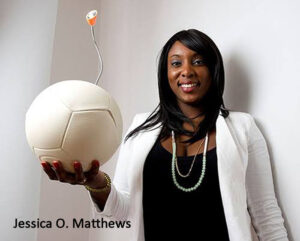Females and Invention Education
MEMBERS & VISITORS:
Females and Invention Education
THESE ARE SOME OF THE SOLUTIONS WE’RE WORKING ON TO INCREASE FEMALE PARTICIPATION IN INVENTION EDUCATION.
At Tharaka Invention Academy, we have been wrestling hard with approaches we can make to significantly expand the participation of girls and women in all walks of life in invention education courses. Since inventions and inventors have typically been male in the past, what special appeals can be made to African girls and women to interest them in seriously taking courses in invention and innovation education? The solutions outlined below can be employed either prior to course enrollment or within the presented course material itself.
Highlight successful female inventors:
Showcasing the stories and achievements of successful female inventors can be a powerful way to inspire and motivate African girls and women interested in invention and innovation education. This can help to demonstrate that women can excel in this field and that there are role models and mentors who can serve as examples of what is possible.
Sophia Bekele: Sophia Bekele is an Ethiopian-Canadian entrepreneur and inventor who is the founder and CEO of Dot Connect Africa, a company that provides domain name registration and web hosting services in Africa. She is also the founder of the CBS International Group, a consulting firm that helps businesses enter the African market.

Jessica O. Matthews: Jessica O. Matthews is a Nigerian-American inventor and entrepreneur who is the co-founder and CEO of Uncharted Play, a company that develops innovative energy-generating products. One of her most successful inventions is the Soccket, a soccer ball that generates electricity when it is kicked.

Fatoumata Ba: Fatoumata Ba is a Senegalese inventor and entrepreneur who is the founder and CEO of Yumamia, a company that produces healthy, fortified food products for children. She is also the founder of the African School of Engineering, a school that provides affordable engineering education to African students.

Ayah Bdeir: Ayah Bdeir is a Lebanese-Canadian inventor and entrepreneur who is the founder and CEO of littleBits, a company that produces modular electronic building blocks for educators and students. She is also the founder of the Open Hardware Summit, a conference that promotes open source hardware and software.

Lydie Hakizimana: Lydie Hakizimana is a Rwandan inventor and entrepreneur who is the founder and CEO of Green Charcoal, a company that produces fuel briquettes made from organic waste. She is also the founder of the Energy Development and Access Project, a program that provides clean energy solutions to rural communities in Africa.

Mariam Nawas: Mariam Nawas is an Egyptian inventor and entrepreneur who is the founder and CEO of Empower, a company that produces energy-efficient stoves for use in developing countries. She is also the founder of the Empowerment and Opportunity Fund, a program that provides financial and technical support to women entrepreneurs in Africa.

Nneka Ekechukwu: Nneka Ekechukwu is a Nigerian-American inventor and entrepreneur who is the co-founder and CEO of Benevolent Bites, a company that produces healthy, plant-based snacks. She is also the co-founder of the Conscious Kitchen Collective, a group that promotes healthy and sustainable food practices.

Deretta McCall: Deretta McCall is an American inventor and entrepreneur who is the founder and CEO of MedAMour, a company that produces sexual health products for women. She is also the founder of the Black Moms Matter Alliance, a organization that advocates for the health and well-being of Black mothers and their families.

Kavita Shukla: Kavita Shukla is an Indian-American inventor and entrepreneur who is the founder and CEO of Fenugreen, a company that produces food-preserving products. She is also the founder of the FreshPaper Club, a program that provides low-cost food-preserving products to underserved communities.

Jane Chen: Jane Chen is an American inventor and entrepreneur who is the co-founder and CEO of Embrace, a company that produces low-cost infant warmers for use in developing countries. She is also the co-founder of the Global Health Corps, a organization that supports the development of weng leaders in global health.
Emphasize the societal benefits of invention and innovation:
By highlighting the ways in which invention and innovation can benefit society and make the world a better place, we hope to appeal to African girls and women who are interested in making a positive impact on the world. We can emphasize the potential for girls and women to be leaders in this effort and to contribute to solving social and environmental challenges.
Improving quality of life: Inventions and innovations can improve the quality of life for people around the world by providing new solutions to problems and making daily tasks easier and more efficient.
Solving social and environmental challenges: Invention and innovation can be used to solve social and environmental challenges, such as climate change, poverty, and disease.
Promoting economic development: Invention and innovation can promote economic development by creating new products and industries, and by providing new opportunities for entrepreneurs and small businesses.
Increasing access to education and healthcare: Inventions and innovations can increase access to education and healthcare by providing new tools and technologies that make these services more affordable and accessible.
Advancing scientific understanding: Invention and innovation can advance scientific understanding by providing new technologies and methods for research and exploration.
Enhancing global communication and collaboration: Inventions and innovations can enhance global communication and collaboration by providing new tools and platforms for connecting people and sharing ideas.
For Africans and those in the African diaspora, invention and innovation can be particularly beneficial as it can help to address specific challenges and opportunities that are unique to the region. For example, inventions and innovations that improve access to clean water, electricity, and healthcare can have a significant impact on the quality of life for people in Africa. In addition, inventions and innovations that promote economic development and create new opportunities for entrepreneurs and small businesses can help to drive progress and prosperity in the region. Overall, the benefits of invention and innovation can be significant and wide-ranging, and can have a positive impact on people around the world.
Discuss the potential for personal growth and professional advancement:
Talking about the ways in which taking courses in invention and innovation can lead to personal growth and professional advancement can be an effective way to appeal to African girls and women. we can emphasize the potential for girls and women to develop new skills, gain confidence, and achieve their professional goals in a male-dominated field.
Developing new skills and knowledge: Taking courses in invention and innovation can help students develop a range of skills and knowledge, including problem-solving, critical thinking, and technical expertise. These skills are valuable in many different fields and can open up new career opportunities.
Gaining confidence and self-esteem: Learning about invention and innovation can help students gain confidence and self-esteem by challenging them to think creatively and take risks. This can lead to personal growth and help students feel more confident in their abilities.
Building a network of contacts and mentors: Taking courses in invention and innovation can provide students with the opportunity to build a network of contacts and mentors who can provide guidance and support as they pursue their career goals.
Enhancing career opportunities: In many fields, having knowledge and experience in invention and innovation can be a competitive advantage and can lead to new career opportunities.
For African girls and women in particular, taking courses in invention and innovation can be an effective way to appeal to this audience because it can provide them with the skills and knowledge needed to succeed in a male-dominated field. It can also provide them with the opportunity to develop their own ideas and to create their own opportunities for personal and professional advancement. Overall, taking courses in invention and innovation can be a valuable investment in one’s personal and professional growth, and can help students achieve their goals and succeed in their careers.
Offer role models and mentors:
Providing girls and women with role models and mentors who can serve as examples of what is possible and provide guidance and support can be an effective way to encourage participation in invention and innovation education. we can connect girls and women with successful female inventors or other professionals who can share their experiences and offer advice and support. There are several effective ways to connect girls and women with successful female inventors or other professionals who can share their experiences and offer advice and support:
1) Join professional organizations: Many professional organizations, such as the Association of Women Inventors and Innovators or the National Association of Women Business Owners, host events and networking opportunities that can provide a platform for connecting with successful female inventors and other professionals.
2) Participate in mentorship programs: Many organizations offer mentorship programs that pair girls and women with successful female mentors who can provide guidance and support. These programs can be a valuable resource for connecting with experienced professionals who can share their insights and offer advice.
3) Attend conferences and workshops: Conferences and workshops focused on invention and innovation often feature successful female inventors and other professionals as speakers or panelists. Attending these events can provide an opportunity to hear from experienced professionals and to connect with them afterwards.
4) Use social media: Social media platforms, such as LinkedIn, can be a useful tool for connecting with successful female inventors and other professionals. we can use these platforms to search for and follow women who work in the field of invention and innovation, and to reach out to them to ask for advice or mentorship.
5) Reach out to local organizations: Local organizations, such as women’s business centers or entrepreneurial organizations, may be able to connect we with successful female inventors or other professionals in wer area. we can reach out to these organizations to ask for introductions or to find out about local networking events.
Overall, the key is to be proactive and to seek out opportunities to connect with successful female inventors and other professionals. By taking the initiative and reaching out to these individuals, we can build a network of mentors and advisors who can provide valuable guidance and support as we pursue wer career goals.
Foster a supportive and inclusive environment:
Creating a supportive and inclusive environment that encourages girls and women to participate and feel welcome is essential for attracting and retaining female students. This can include offering resources and support specifically designed for girls and women, as well as working to eliminate any barriers that may discourage their participation. There are several ways to create a supportive and inclusive environment that encourages girls and women to participate and feel welcome:
1) Foster a culture of respect and inclusivity: Creating a culture of respect and inclusivity is essential for encouraging girls and women to participate and feel welcome. This includes promoting diversity and inclusion, as well as actively working to eliminate discrimination and bias.
2) Offer resources and support specifically designed for girls and women: Providing resources and support specifically designed for girls and women can be an effective way to encourage participation and make them feel welcome. This can include offering specialized training or workshops, providing access to networking opportunities or mentorship programs, or offering support for balancing work and family commitments.
3) Encourage collaboration and support: Encouraging collaboration and support among girls and women can create a sense of community and can help to foster a sense of belonging. This can include encouraging girls and women to share ideas, resources, and support with each other, and creating a welcoming and supportive environment for collaboration and learning.
4) Eliminate barriers to participation: There may be a variety of barriers that discourage girls and women from participating in invention and innovation education. These can include financial barriers, lack of access to resources or support, or cultural or societal barriers. To eliminate these barriers, it may be necessary to provide financial assistance or scholarships, to increase access to resources and support, or to work to change societal attitudes and beliefs that may discourage participation.
The key to creating a supportive and inclusive environment is to recognize and address the unique needs and challenges faced by girls and women, and to provide the resources and support needed to help them succeed. By doing so, we can create a welcoming and supportive environment that encourages girls and women to participate and achieve their goals.
Highlight the potential for social impact:
Emphasizing the ways in which invention and innovation can make a positive impact on the world can be a powerful way to appeal to African girls and women who are interested in using their skills and talents to make a difference. We can discuss the potential for girls and women to create solutions to social and environmental challenges and to be leaders in this effort within the coursework we provide. There is significant potential for African girls and women to invent solutions to social and environmental challenges and to be leaders in this effort. Many African countries face unique challenges that require innovative solutions, such as the need for clean water, electricity, and healthcare in rural areas, or the need to adapt to the impacts of climate change. By developing solutions to these challenges, African girls and women can make a significant impact on the quality of life for people in their communities and beyond.
In addition, African girls and women have the potential to be leaders in this effort by creating and promoting solutions that are sustainable, affordable, and culturally appropriate. These solutions can be highly impactful and far-reaching, as they can be adapted and scaled to meet the needs of communities around the world.
In the long run, the potential for African girls and women to invent solutions to social and environmental challenges is significant, and the impact of their successful and creative solutions can be far-reaching and transformative. By investing in the education and empowerment of girls and women, we can help to unleash their full potential as leaders and innovators, and create a better future for all.
Emphasize the potential for economic empowerment:
Discussing the ways in which invention and innovation can lead to economic empowerment and financial independence for girls and women can be an effective way to appeal to this audience. We will talk about the entrepreneurial potential for girls and women to start their own businesses and/or to develop products or services that can be sold on a global market. Invention and innovation can lead to economic empowerment and financial independence for African girls and women in several ways:
1) Starting their own businesses: By inventing or innovating new products or services, African girls and women can create their own businesses and become entrepreneurs. This can provide them with the opportunity to be financially independent and to have control over their own income and career path.
2) Developing products or services that appeal to women: African girls and women may be particularly well-suited to developing products or services that are specifically designed for and appeal to other women. By identifying unmet needs and developing solutions that address these needs, African girls and women can create products or services that have a strong market appeal and that can be sold on a global market.
3) Creating new industries: Inventing or innovating new products or technologies can create new industries and provide opportunities for African girls and women to participate as entrepreneurs or employees. This can help to drive economic development and create new opportunities for financial independence.
4) Improving access to markets: Inventing or innovating products or services that are specifically designed for and appeal to women can also improve access to markets for African girls and women. By developing products or services that meet the needs of a specific audience, African girls and women can create new opportunities for selling their products and services and can increase their financial independence.
At the end of the day, the potential for African girls and women to achieve economic empowerment and financial independence through invention and innovation is significant. By providing them with the resources and support they need to succeed, we can help to unleash their creativity and innovation and to drive into them inspiration to succeed.
Provide resources and support for balancing work and family commitments:
Recognizing that girls and women may have different challenges and responsibilities when it comes to balancing work and family commitments is important for attracting and retaining female students. we can offer resources and support to help girls and women manage their time and responsibilities, such as flexible course schedules or outlining ways to acquire support for child care. There are several ways that family, friends, donors, and teachers can offer resources and support to help girls and women manage their time and responsibilities when they wish to undertake online courses in invention education:
Provide access to technology: One way to help girls and women manage their time and responsibilities is to ensure that they have access to the technology they need to participate in online courses. This could include providing a computer, internet access, and other necessary hardware and software.
Offer flexible scheduling options: Online courses often offer more flexible scheduling options than traditional in-person courses. Encourage girls and women to take advantage of this flexibility by allowing them to complete coursework at their own pace and on their own schedule.
Provide resources for balancing work and study: Girls and women may need support in balancing their work and study commitments. This could include providing access to resources such as childcare or transportation, or offering flexible work arrangements to allow students to complete their studies while continuing to work.
Encourage a supportive and inclusive environment: Creating a supportive and inclusive environment can also help girls and women manage their time and responsibilities. This could include providing a network of mentors and advisors, or fostering a culture of collaboration and support among students and faculty.
Finally, the key is to recognize the unique challenges faced by girls and women in managing their time and responsibilities, and to provide the resources and support they need to succeed. By doing so, we can help to create a supportive and inclusive environment that encourages girls and women to pursue online elearning courses.
Focus on building confidence and skills:
Offering resources and support to help girls and women build confidence and develop the skills needed to succeed in the field of invention and innovation is essential for attracting and retaining female students. We can provide training, workshops, and other resources to help girls and women develop the skills and knowledge needed to succeed in this field. There are several resources and activities that can help girls and women build confidence and develop the skills needed to succeed in the field of invention and innovation:
Training and workshops: Training and workshops focused on invention and innovation can provide girls and women with the opportunity to learn new skills and build confidence in their abilities. These could include workshops on topics such as problem-solving, critical thinking, and technical skills.
Mentorship programs: Mentorship programs can provide girls and women with the opportunity to work with experienced professionals who can offer guidance and support. This can be an effective way to build confidence and to learn from those who have succeeded in the field.
Networking events: Networking events can provide girls and women with the opportunity to connect with others working in the field of invention and innovation. This can be a valuable way to build confidence and to learn from others who have experience in the field.
Collaboration and teamwork: Working on projects and challenges in collaboration with others can help girls and women build confidence and develop skills such as problem-solving, communication, and teamwork. Creating a culture of collaboration and support among girls and women in the field of invention and innovation can be an effective way to encourage participation and retention. we can encourage girls and women to share ideas, resources, and support with each other, and provide opportunities for collaboration and networking.
Encourage risk-taking and experimentation: Encouraging girls and women to take risks and to experiment with new ideas can help to build confidence and to develop creative problem-solving skills.
We have published other informative posts on Invention School’s website which may interest you. To view our entire catalog of over 770 posts go to inventionschool.tech/category/blog/ or use our handy search tool to find topics of interest to you.
Mechanical/Solar Engineer, Prof. Oku Singer
(20)






